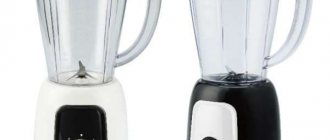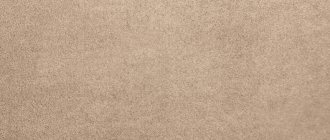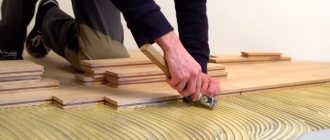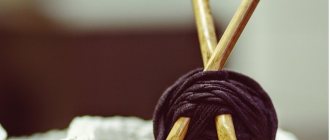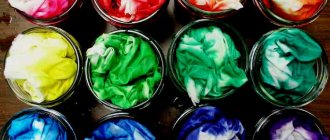What is MDF
The material received its unusual name due to its abbreviation. The full name is “finely dispersed fraction”.
External differences in materials
Many people are interested in how MDF differs from laminated chipboard in appearance, and how to identify them? The difference is clearly visible in the cut. In MDF it is dense, fine-grained, in chipboard or laminated chipboard it is more heterogeneous, rough, and shavings are visible. On the surface of chipboard without lamination, fibers and shavings are clearly visible, while MDF is more uniform.
If you take MDF and laminated chipboard boards of the same size (in area and thickness), then the weight of the particle board will be less than that of fine particle board.
If there is a milled, carved surface on the material, we can definitely say that it is not laminated chipboard, since nothing can be cut on it. You can’t make small parts from it either, since the material will crumble.
Production
To produce both materials, wood production waste is used: knots, branches, crooked trunks, trimmings.
All these materials turn into small chips, which subsequently become the base of MDF or chipboard.
And here lies the first difference between these two materials: For laminated chipboard, the chips are made quite large; for MDF, the blanks are crushed to the smallest possible size.
The second difference is related to the process of combining sawdust and shavings into a single mass:
- For more modern material, the hot pressing method is used;
- For the manufacture of chipboards, formaldehyde resins are used, which are not particularly safe.
At the same time, MDF already has a smooth and soft structure, completely ready for furniture production; laminated chipboard requires additional sanding.
Laminated chipboard - what is it?
Chipboard (chipboard) is compressed wood sawdust and shavings; formaldehyde resins are used as an impregnation and binding composition. The slab has a heterogeneous structure; the density, depending on the grade, is 300–600 kg/m3. For the production of furniture, types with high performance are used. More loose varieties are used for technical purposes or as packaging material.
Next, the chipboard is laminated - covered with a layer of melamine film under high pressure. The result is a laminated chipboard (laminated chipboard) material that is ready for use in furniture production.
The coating performs several functions:
- prevents the release of formaldehyde, which is quite harmful to the human body;
- protects the stove from external influences and moisture;
- gives the slab an attractive appearance - laminating films of various colors, decors and textures are used to make furniture laminated chipboards.
There is an international classification of the environmental safety of laminated chipboard. High-quality material used in the manufacture of household furniture must comply with class E1. When purchasing, check with the seller and ask to see certificates. Products of class E2 are completely prohibited in Europe and have significant restrictions on use in Russia.
Advantages of materials
Both materials are in great demand due to their undoubted advantages. These include:
- A wide selection of colors and patterns helps to create furniture suitable for decorating a wide variety of rooms.
- Durability. The materials are quite resistant to mechanical damage and are not susceptible to invasion by bugs and other unwanted inhabitants of natural wood.
- Hygiene. The coating of both materials tolerates wet cleaning and the use of household chemicals well.
- Durability. If you follow simple rules, the materials will last for quite a long time, without requiring additional efforts to maintain an attractive appearance.
- Nice price. Unlike wood, MDF and laminated chipboard are quite available for purchase as part of cabinet furniture, and modern films make them practically indistinguishable from natural materials.
Designer tips - what is the difference between materials
Designers can also advise which furniture is better, made of MDF or chipboard. If you take two samples of facades, at first glance you may not immediately be able to determine what they are made of. Both facades are budget alternatives to using expensive natural wood.
Thanks to the fashion for the Art-Decor style, when classics are combined with modern fashionable materials, you can successfully play with such facades. Paint them in loft, minimalism, and achieve very interesting effects.
Straight-shaped facades are most often used in modern interiors and rectilinear design projects. The most popular is painted glossy or veneered MDF.
Modern fashion trends tend to combine bright colors with MDF with natural wood veneer. It is permissible for a predominance of both a dark bottom and a light top, and vice versa.
The top drawers should not visually appear massive and large. Laminated MDF panels for walls completely replicate the texture of natural wood. Visually it is difficult to find the differences. These panels can also be used to decorate the ceiling.
For a kitchen, it is necessary that the material is not only beautiful, but also practical. Matte painted facades from Italian designers are in fashion now.
Ultra interesting design options are now being created with matte facades. Gloss is easier to maintain. Various contaminants are less visible on it. For practical people, it is better to choose furniture from glossy MDF panels. Using the advice of designers, you can successfully purchase furniture.
When choosing furniture made from chipboard and MDF, the difference will be in cost and quality . However, both panels can be successfully used if you need to purchase budget furniture.
Advantages of MDF
At the same time, a more modern coating has additional attractive properties.
It:
- Has high strength and resistance to chipping;
- Less susceptible to moisture;
- Suitable for creating complex designs and carvings.
Basic similarities of materials
The main similarity of the materials is that they are a cheaper analogue of natural wood and are used in the production of kitchen sets, living room cabinets, bedside tables, beds and other furniture elements. There is a wide variety of color solutions on the market, which allows you to bring the most daring design ideas to life.
Wood panels require the same care. It is recommended to avoid exposure to high temperatures: at 75 degrees or more, peeling of coatings is possible. You should avoid exposure to direct sunlight: this is how the paint (film) loses its shine and fades. Prolonged contact with water is undesirable: this leads to swelling of sawdust and subsequent deformation of furniture products.
Disadvantages of materials
The main disadvantage is the flammability of the materials. However, a similar drawback is present in all objects created from wood or its derivatives.
The second unpleasant moment will be the formation of cracks or chips when heavy objects fall onto the surface or careless handling of sharp objects.
What to consider when choosing kitchen furniture made from MDF and chipboard
If the kitchen is spacious, choose a large table. It can be placed in the center of the room when guests arrive. Several chairs can be placed around the table. It is good to choose oval or round tables.
Table models should be combined with the style of other kitchen furniture. A transformer is good for small rooms. It does not take up much space when folded.
All materials from which the furniture is made must be resistant to steam and moisture. For such furniture, choose only high-quality chipboard or MDF materials.
So that they do not become deformed over time. By choosing glossy surfaces, you can ensure a minimum of cleaning worries. On such furniture stains from grease and other contaminants will not be visible. Matte surfaces are more whimsical, although today they are in fashion. Simple tips for choosing a custom-made kitchen.
Comparison of main characteristics
Despite almost the same composition and similar characteristics, the materials have slightly different performance properties:
- Density. This indicator is slightly higher for MDF, so it becomes stronger and more resistant to damage.
- Moisture resistance. Laminated chipboard has much better performance than its untreated predecessor. But it is also inferior to MDF in this property. However, the latter material also does not really like water. The areas that suffer the most from moisture are not very neatly sealed joints and corners. Therefore, when purchasing, you should pay special attention to the edges of the products.
- Durability. This indicator is influenced by strength, moisture resistance and ability to withstand impacts. All these characteristics are higher in MDF, so a panel made from fine wood fraction still has a chance to live longer. In addition, chipboard does not really like re-screwing screws or hammering nails.
- Environmental friendliness. Formaldehyde, which is part of chipboard, can release dangerous fumes when heated strongly, so it is considered a more harmful material. But in ordinary life it is completely safe. And yet, if there is a choice, it is better to give preference to MDF.
- Flammability. In terms of this indicator, laminated chipboard wins; it is more resistant to heat and fire.
- Price. In terms of loyalty to the wallet of the future owner, laminated chipboard is the leader, but due to its longer service life, this saving may be dubious.
Appearance. In appearance, both materials are not very different from each other. However, MDF has more possibilities for creating a more attractive design. The material can withstand milling and creating patterns, and can be finished with natural veneer. So in beauty it is not much different from solid wood.
Most often, products made from chipboard are purchased for quick furnishing of premises and subsequent replacement with higher quality items. MDF remains an investment for a longer period.
What to choose
You can choose different materials for different rooms. It depends on the wishes of the owners, their capabilities, as well as the purpose of the room.
- Living room. The room is not subject to changes in temperature and humidity, so both materials will look equally good here. However, preference is still given to the more resistant and durable MDF, which also has more sophisticated patterns.
- Bedroom and children's room. For both premises, environmental friendliness plays a major role, so if it is not possible to use natural wood, the choice is still made in favor of MDF.
- Kitchen. The undisputed leader is MDF, which is more resistant to moisture and temperature changes. Laminated chipboard is used if you need to leave the room quickly, but there is not much money.
- Bathroom and toilet. Both materials are not very suitable for furnishing these rooms due to their dislike of moisture. But if there is a need to equip a “wet” room with a set of wood waste, then choose the more moisture-resistant and durable MDF. In this case, special attention is paid to finishing the edges of the product.
- Hallway. Usually there is not too much load on the furniture in the hallway. For the entrance area, it is still better to buy furniture made of MDF, but laminated chipboard will also work well.
What to choose for each room?
The advantages of MDF are obvious, but it is an expensive material. Furniture made entirely from MDF is rare. Manufacturers usually offer combined options. The cases in the vast majority of products on the market are made from laminated chipboard, and the facades are made from MDF, laminated chipboard or a combination of both. This approach allows you to use all the aesthetic advantages of MDF and prevent a significant increase in the cost of products.
For a layman, the difference between materials in finished furniture is not always obvious. This can often be determined by its appearance - parts with milling and bends are made only from MDF.
For each room in the house, optimal recommended solutions can be identified for the selection of materials in accordance with operating conditions.
- Living room, hallway. For cabinets, cabinets and other furniture in general rooms, you can choose facades from any material in accordance with your budget and individual appearance requirements. In order to save the family budget, laminated chipboard is also quite suitable.
- Kitchen. Here the furniture is subjected to special loads, changes in temperature and humidity, and exposure to food contaminants. If finances allow, purchase a set with MDF facades.
- Bathroom. Here it is definitely recommended to install furniture entirely (including the body) made of MDF. The low moisture resistance of chipboard automatically excludes the use of this material in rooms with high humidity.
- Bedroom. It is better to prefer sets made of MDF. Furniture made from laminated chipboard is acceptable only if it is of very high quality, with careful processing of edges and joints.
- Children's room. In terms of environmental indicators, MDF is undoubtedly better than laminated chipboard.
When choosing materials for furniture, it is necessary to proceed from the operating conditions of the products and financial capabilities. Cost is the only point in favor of chipboard. All other things being equal, MDF is the preferred material for the manufacture of furniture facades. Such products have all the advantages of natural wood, and in terms of strength and moisture resistance they even surpass natural wood, while being much cheaper. A wide selection of finishing materials allows us to produce furniture to suit the individual requirements of each customer.
Photos of the use of MDF and chipboard
Advantages and disadvantages of laminated chipboard
To understand how laminated chipboard differs from MDF in furniture, we list its advantages and disadvantages. The advantages include:
- wide variety of colors and textures;
- rigidity, due to which the material is often used in the production of furniture frames;
- resistance to mechanical stress and cleaning with aggressive substances;
- affordable price (products made from it are on average 1.5-2 times cheaper than similar products made from MDF).
The main disadvantages of laminated chipboard are:
- low strength, instability to chips and mechanical damage;
- low moisture resistance;
- impossibility of milling;
- low environmental friendliness (possibility of harmful emissions).
In practice, laminated chipboard is used in more than 95% of cases to create the frame of kitchens or living room furniture. Facades are made from MDF because this material is more suitable for artistic processing or creating unusual shapes.
Experts advise that when purchasing furniture made from chipboard, give preference to raw materials of the “E0.5” or “E1” class: they emit formaldehyde in a minimal amount. The selected products should be carefully inspected: it is important that the edges are well sealed and that there are no scratches, chips or other damage on the laminate layer.
Requirements for kitchen furniture materials
The kitchen set occupies the bulk of the space, so the color of the furniture affects the overall perception of the interior. The first requirement for facades lies in the design plane: their shade must correspond to the overall style of the kitchen and fit harmoniously into the room.
The second point concerns technical issues. The operating conditions of surfaces in the kitchen are quite harsh: they are always in contact with fat, water, sharp objects and hot dishes. When buying furniture, you need to take into account all the nuances.
Basic requirements for materials:
- Appearance. Households spend a lot of time in the kitchen, so the aesthetic component of the facades plays an important role.
- Environmental friendliness. In the room, elevated temperatures often prevail in the area of the stove, and raw materials should not emit harmful substances when heated.
- Strength. Kitchen surfaces are heavily used and therefore must be resistant to chemical, mechanical and thermal damage.
- Easy care. Facades must be cleaned well and quickly, resist stains and be easily restored.
- Price. It is more profitable to buy expensive furniture because it is made with high quality and will last longer.
When choosing a product, you should take into account both the decorative component and the technical characteristics of the raw materials.
Treated MDF - LMDF
It is simply not rational to produce laminated MDF in various colors - after all, furniture factories will still paint it, cover it with PVC film or veneer. Therefore, manufacturing plants produce LMDF in only one color - white - it can easily be found on the back side of painted facades.
Is it possible to order MDF from EGGER factory, decorated in the same way as chipboard? Answer: Yes, but this order must be VERY large - several hundred sheets.
What is laminated chipboard - pros and cons for the kitchen
Chipboard - chipboard. It began to be produced at the beginning of the last century. At first, the quality was low, but over time, technology has improved and now it is the most popular material for making furniture, including kitchen furniture. Laminated chipboard is a laminated chipboard, that is, a wood board coated with a protective top layer that gives an aesthetic appearance.
Chipboard production process:
- Wood processing, production of sawdust.
- Grinding sawdust to obtain smaller chips.
- Drying wood pulp in special equipment.
- Wood shavings are sifted to separate the smallest particles, and larger ones are sent for recycling.
- Sorted small shavings are mixed with formaldehyde resin. This synthetic substance is used to glue sawdust and produce a solid, durable layer of chipboard.
- The resulting mixture is sent to the conveyor, where a rough chipboard sheet is formed.
- The workpiece is carefully sanded, the chipboard sheet acquires a smooth, even surface.
- Finishing is the application of a polymer film, which protects against the release of formaldehyde vapors and gives a decorative appearance to the material.
Finished laminated chipboard sheets are cut according to templates of standard sizes.
Advantages of laminated chipboard
Laminated chipboard material has become the most popular in kitchen production due to the following properties that are important for consumers:
- the price of laminated chipboard is lower than that of MDF and solid wood;
- tolerates the effects of humidity and temperature changes in the kitchen;
- durable, resistant to mechanical damage to the surface;
- Almost any chemicals are suitable for washing, except acid-containing ones;
- large selection of colors. On sale there are always chipboards with a colored laminated surface and options made to look like natural wood.
If there are flaws in the laminated chipboard coating, then the resistance to moisture and heat is reduced. For example, the film on the corners of a chipboard sheet is not properly applied and secured. This means that if water gets into the joints, the wood board will soon swell and lose its aesthetic appearance.
If there are voids between the surface of the chipboard and the polymer film, then when it comes into contact with a hot object, such part of the sheet will be deformed.
Disadvantages of laminated chipboard
The main negative point when using laminated chipboard in the kitchen is the formaldehyde content in its composition. When heated, toxic substances can be released into the air, which negatively affects human health. The most dangerous in this regard is chipboard with an uncoated surface, since lamination allows you to reduce the percentage of released toxins.
The content of toxic substances in laminated chipboard discourages many from purchasing a kitchen made from this material. But not everyone knows that there are two types of chipboards - E1 and E2. This marking allows you to choose the safest material.
Type E1 means that per 100 g of chips the resin content is 10 g. In E2, the same amount of sawdust accounts for 30 grams. resin. When choosing laminated chipboard for the kitchen, you should make sure that it is marked E1; such material is relatively safe.
Another negative feature of laminated chipboard is its rigidity; the finished board cannot be processed, and therefore is not suitable for creating shaped products. If you plan to make a kitchen set with a carved pattern, then MDF is suitable for such purposes, but not laminated chipboard. Even for normal cutting, it is necessary to use factory equipment. Cutting with a regular saw will result in chipping.
MDF or chipboard. What's best for children?
When choosing a children's room, we are, of course, concerned about the safety and environmental friendliness of future furniture.
Of course, a lot depends on the character of the child and the period for which you purchase furniture. For a long time or, for example, until the moment when the child goes to gnaw on the granite of science. If you have a hooligan boy growing up who conducts experiments on everything he sees, then MDF is your option. And if you have a gentle and neat excellent student growing up, then you may well make a choice in favor of chipboard.
CALCULATE THE COST
CALCULATE THE COST
Visit any of our Mr.Doors furniture showrooms with your children! We guarantee that you will experience a lot of positive emotions and get an answer to every question you have! You will be pleasantly pleased with professionalism, willingness to help, individual approach and high-quality service.




